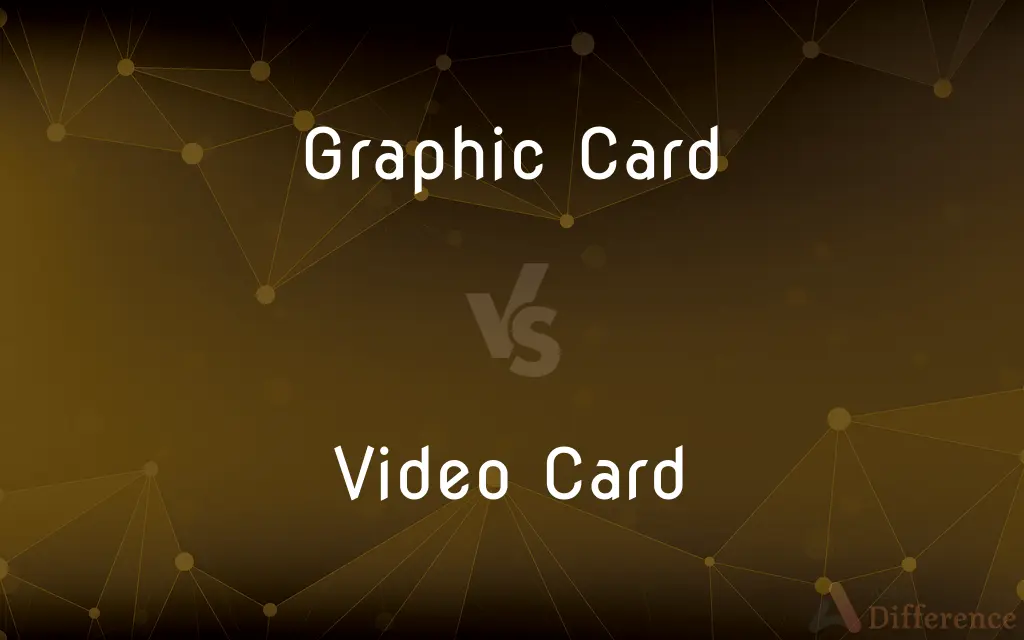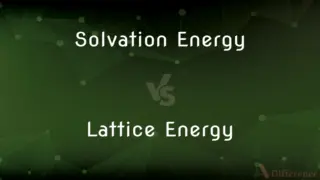Graphic Card vs. Video Card — What's the Difference?
By Urooj Arif & Fiza Rafique — Published on August 7, 2024
Graphic Card is a broad term for hardware accelerating graphics rendering, often used interchangeably with Video Card, which specifically refers to components rendering images to a display.

Difference Between Graphic Card and Video Card
Table of Contents
ADVERTISEMENT
Key Differences
Graphic Cards are integral components in computers and gaming consoles designed to enhance the rendering of graphics, animations, and video playback. They contain a graphics processing unit (GPU), memory, and cooling systems to handle complex calculations related to 3D graphics and image processing. On the other hand, Video Cards, often considered synonymous with Graphic Cards, specifically focus on outputting images to a display. They include outputs like HDMI or DisplayPort and are crucial for gaming, video editing, and content creation.
While both terms are used interchangeably in many contexts, Graphic Cards can sometimes refer to a broader category that includes professional graphics cards used in workstations for CAD, 3D modeling, and video editing. These are optimized for different tasks than typical Video Cards, which are often geared towards gaming and multimedia consumption.
The primary function of Graphic Cards is to accelerate the rendering of 3D graphics and visual effects so that the CPU is not overburdened with these tasks. This allows for smoother gameplay, faster video rendering, and more efficient software operation. Video Cards, in their role within this context, serve to connect monitors and manage the display of the rendered images, ensuring that users see high-quality visuals on their screens.
In terms of hardware, both Graphic and Video Cards are equipped with a GPU, but the specific architecture and features can vary significantly based on the intended use case. Gaming-oriented Video Cards, for instance, may prioritize high frame rates and support for gaming technologies like ray tracing, whereas Graphic Cards for professional use might focus on color accuracy, computational reliability, and support for multiple displays.
When considering upgrades or purchases, the distinction between Graphic and Video Cards becomes more about the card’s intended use rather than its technical specifications. Consumers looking for enhanced gaming performance or better multimedia playback will find that both terms refer to products that can meet their needs, whereas professionals might seek out "Graphic Cards" with specific features tailored to their industry requirements.
ADVERTISEMENT
Comparison Chart
Definition
Broad term for components accelerating graphics rendering.
Often used interchangeably with Graphic Card; specifically outputs images to displays.
Primary Use
Enhancing graphics, animations, and video playback.
Rendering and outputting images for monitors, focused on display quality.
Key Components
GPU, memory, cooling system.
GPU, memory, outputs like HDMI/DisplayPort.
Use Case Variety
Includes gaming, professional graphics work (CAD, 3D modeling).
Primarily gaming, video editing, and multimedia consumption.
Professional vs. Gaming
Professional cards optimized for precision and complex calculations.
Gaming cards focus on high frame rates and advanced gaming features.
Compare with Definitions
Graphic Card
Built around a powerful GPU.
Graphic Cards use advanced GPUs for efficient processing of graphics tasks.
Video Card
Enhances video watching experience.
Video Cards provide hardware acceleration for 4K videos.
Graphic Card
Designed to dissipate heat efficiently.
Modern Graphic Cards come with sophisticated cooling solutions.
Video Card
Includes HDMI/DisplayPort outputs.
Video Cards offer multiple ports for connecting different displays.
Graphic Card
Accelerates rendering of 3D graphics.
The Graphic Card enables high-fidelity gaming experiences.
Video Card
Focuses on delivering visuals to monitors.
Video Cards ensure crisp and vibrant images for multimedia.
Graphic Card
Equipped with dedicated memory.
Graphic Cards with more memory handle complex scenes better in games.
Video Card
Prioritizes features for gamers.
Video Cards with high frame rates improve gaming smoothness.
Graphic Card
Suited for CAD and video editing.
Graphic Cards like NVIDIA Quadro are preferred for architectural design.
Video Card
Widely available for PC enhancements.
Upgrading a Video Card can significantly boost computer performance.
Common Curiosities
Are Video Cards necessary for video editing?
While not strictly necessary, Video Cards significantly improve video editing performance by accelerating graphics processing.
What is a Graphic Card?
A component designed to accelerate the rendering of graphics, animations, and video playback in devices.
Can you use a Graphic Card for gaming?
Yes, Graphic Cards are commonly used to enhance gaming experiences by rendering high-quality graphics smoothly.
How do Graphic Cards impact computer performance?
They offload graphics processing from the CPU, leading to smoother visuals and better overall performance.
How does a Video Card differ from a Graphic Card?
Video Card is often used interchangeably with Graphic Card but specifically refers to the component that outputs images to a display.
What makes professional Graphic Cards different?
They are optimized for precision and complex tasks like CAD and 3D modeling, offering features like higher memory capacity.
How do I know if my system needs a new Graphic Card?
If you experience poor graphics performance, slow video rendering, or want to run more advanced applications, consider an upgrade.
What is ray tracing in Video Cards?
Ray tracing is a technology that simulates realistic lighting effects in games, available in some high-end Video Cards.
Do I need a high-end Video Card for everyday use?
For basic tasks like web browsing and office applications, a high-end Video Card is not necessary.
What should I look for in a Graphic Card for professional use?
Look for cards with higher memory, precision calculations, and support for professional software.
Are all Video Cards compatible with any computer?
Compatibility depends on factors like power supply, space within the case, and motherboard connections.
Can I upgrade my Video Card for better gaming performance?
Yes, upgrading your Video Card can significantly improve gaming graphics and performance.
Can Graphic Cards be used for machine learning?
Yes, certain Graphic Cards are suitable for machine learning tasks due to their computational power and efficiency.
Do Video Cards affect monitor resolution?
Yes, the capabilities of a Video Card determine the maximum resolution and refresh rate that can be supported on connected displays.
How often should I upgrade my Graphic Card?
Upgrade cycles vary by user needs, but generally, every 3-5 years is common for gamers or professionals seeking the latest advancements.
Share Your Discovery

Previous Comparison
Solvation Energy vs. Lattice Energy
Next Comparison
Apes vs. HumanAuthor Spotlight
Written by
Urooj ArifUrooj is a skilled content writer at Ask Difference, known for her exceptional ability to simplify complex topics into engaging and informative content. With a passion for research and a flair for clear, concise writing, she consistently delivers articles that resonate with our diverse audience.
Co-written by
Fiza RafiqueFiza Rafique is a skilled content writer at AskDifference.com, where she meticulously refines and enhances written pieces. Drawing from her vast editorial expertise, Fiza ensures clarity, accuracy, and precision in every article. Passionate about language, she continually seeks to elevate the quality of content for readers worldwide.












































